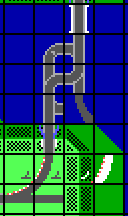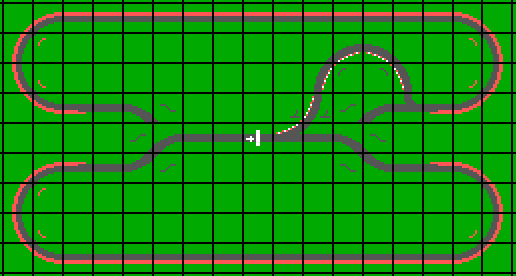Illusion track
The term illusion track refers to a loosely defined category of tracks which incorporate any of a number of special effects not achievable through the in-game editor. Such effects range from mirages and visual illusions to wholly new track parts from the combination of the standard elements. Creation and modification of illusion tracks require an external track editor such as Track Blaster; even opening them with the in-game editor will destroy the special effects. Flooded tracks are very similar to illusion tracks in that respect; they are not, however, usually called illusion tracks due to their ubiquity (i.e. every other competition track has at least one flooded sector).
General techniques
Illusion track building is based on three techniques, often seen in conjunction: terrain manipulation, filler tile manipulation and track continuity manipulation.
Terrain
Most Stunts elements are not supposed to be placed anywhere but in a flat piece of terrain, be it on the base ground or on the top of a hill. For multi-tile elements in particular, all tiles were originally meant to lie at the same height, in a flat surface. Violating these assumptions will lead to weird, and occasionally useful, visual and physical effects.
Filler tiles
Multi-tile elements are defined by the topmost or leftmost tile (for 2x1 elements) or the top-left tile (for 2x2 elements). The other tiles are just interchangeable filler tiles, and can be replaced at will as long as the track continuity is not broken. That is the source of, among other effects, most of the mirage tricks - if a filler tile is replaced by a single-tile element, the single-tile element will only appear at very close distances; from afar the whole multi-tile element will be visible, even the parts which are actually missing.
Track continuity
When testing whether a track is broken or not, the in-game track validation only checks if the element is entered through a valid entry tile and if the exit tile, defined according to the element main tile (i.e. the topmost/leftmost one), leads to the entry tile of another element. As a consequence, at most two tiles of a multi-tile element need to be present for continuity to be unbroken (and just one if the entry tile and the main tile coincide). That gives leeway for significant continuity manipulations - for instance, creating a legal but undrivable path made of incomplete multi-tile elements in order to hide a stretch of track with broken continuity from the validation.
Examples
Illustrations of some illusion effects which can be reached using the techniques described above. The competition tracks mentioned below are available from the Competition Archive.

Invisible corners
A distinctive mark of Krys TOFF's tracks; seen, for instance, in his ZCT76 (ZakStunts 2007). Achieved by placing the main tile of a corner on an inner angled slope with matching orientation; that will lead the corner to appear to be as if it is in low ground even if it is actually on the top of a hill, and thus make the ground invisible from inside the car. Possible orientations of the corner: any with a small corner, east-to-south and west-to-north with a large corner (other orientations would have the slope intersecting the road, with rather more bizarre results).

Broken l/r cork
A simple example of mirage effect, seen in tracks such as Mexicana (WSC 2007) and ZCT137 (ZakStunts 2012). Reached by replacing the filler tile of a cork l/r with a single-tile element, or simply by removing it. A track with a broken l/r cork will, in most cases, only be drivable in the direction along which the main tile of the cork is reached first, as the track continuity will be broken in the opposite direction.

Bridge chicane
A poor man's new track element, first seen on ZCT106 (ZakStunts 2010). Built by matching the upper quarter-turns of u/d corks with appropriate orientations. The visual effect, though not perfectly clean (from a distance the chicane will look like overlapping corks), is not disorienting either. Unfortunately only two orientations are possible, given the complexity of the assemblage: right-left chicane from north to south and left-right chicane from west to east. As the second cork u/d is not a part of the track as far as track validation is concerned, an extra fake path is necessary to fool the game engine.
Symmetrical dual-way splits and rejoins
Constructed by fusing chicanes which are mirror images of each other. A fake continuation is needed for one of the paths at the split; no such thing is necessary for the rejoin. The visual effect is nearly flawless if the fake path used at the split does not overlap with the chicanes, as in the track displayed below (though using an overlapping path, which is possible for most orientations, can save some space).

